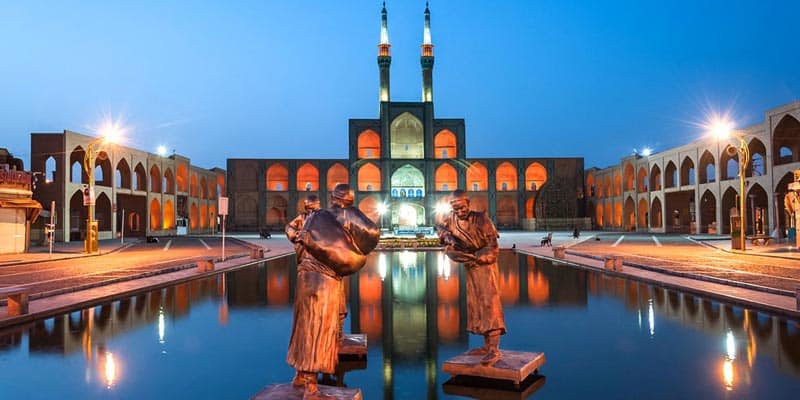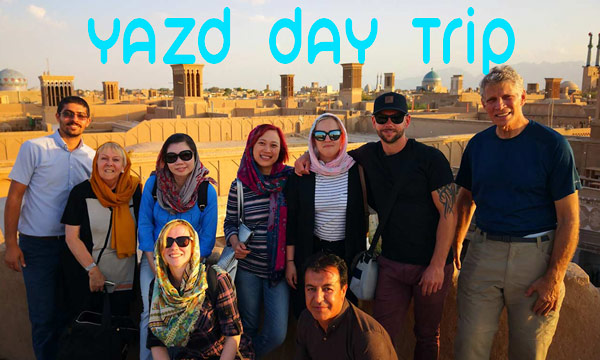🏜️ Yazd Travel and City Guide: Discover Iran’s Desert Jewel
Step into Yazd, where time slows down and ancient traditions dance with desert winds. Tucked between Iran’s central deserts, this UNESCO-listed city is a living museum of Zoroastrian fire temples, mudbrick labyrinths, and ingenious windcatchers (badgirs) that whisper stories of sustainability centuries ahead of their time.
Often bypassed by hurried tourists, Yazd is a hidden gem that rewards the curious traveler with peace, history, and a culture untouched by modern chaos.
📍 Where Is Yazd?
-
Location: Central Iran, 620 km southeast of Tehran
-
Elevation: ~1,200 meters above sea level
-
Climate: Dry desert climate – hot summers, cool winters
-
Best Time to Visit: March to May & September to November
✨ Why Visit Yazd?
-
🏜️ Wander the oldest adobe city in the world, still inhabited
-
🔥 Discover the heart of Zoroastrianism at the Fire Temple and Towers of Silence
-
🌬️ Marvel at ancient windcatchers, the original air conditioners
-
🧕 Experience authentic Iranian hospitality in eco-lodges and boutique hotels
-
🧶 Shop for handwoven silk, copperware, and sweets in traditional bazaars
-
📸 Capture otherworldly views of sunsets over mudbrick rooftops
🏛️ Top Attractions in Yazd
🕌 Yazd Old City (Historic Center) – UNESCO World Heritage Site
-
A maze of narrow, winding alleys lined with mudbrick homes
-
Earth-toned domes, sun-drenched courtyards, and hidden rooftop cafés
-
Best explored on foot or with a local guided walking tour
🔥 Zoroastrian Fire Temple (Atashkadeh)
-
Home to a sacred fire believed to have been burning for over 1,500 years
-
A spiritual insight into Zoroastrianism, Iran’s pre-Islamic religion
-
Visit the museum next door for ancient texts and artifacts
🏜️ Towers of Silence (Dakhmeh)
-
Hauntingly beautiful Zoroastrian burial towers atop desert hills
-
Panoramic views and profound silence
-
Ideal for sunrise or sunset visits
🌬️ Dowlat Abad Garden & Windcatcher
-
A stunning Persian garden with the tallest badgir in the world (33m)
-
Clever traditional cooling system in action
-
A perfect blend of engineering and elegance
🕌 Jameh Mosque of Yazd
-
Iconic 12th-century mosque with tall minarets and exquisite tilework
-
A photographer’s dream, especially at blue hour
-
Still active as a place of worship
🏞️ Nature & Desert Adventures
🚙 Varzaneh & Dasht-e Kavir Desert
-
Close proximity to sand dunes, salt lakes, and camel rides
-
Overnight desert camping tours under a sky full of stars
-
Sandboarding and jeep safaris available for thrill-seekers
🏕️ Saryazd Fortress
-
A well-preserved mudbrick castle just outside Yazd
-
Used as a caravanserai and safehouse for merchants
-
Offers a glimpse into Yazd’s Silk Road past
🌅 Chak Chak (Pir-e Sabz)
-
Zoroastrian pilgrimage site set in desert cliffs
-
Famous for drops of holy water that ‘weep’ from stone walls
-
Ideal for half-day trips with historical context
🛍️ Shopping in Yazd: Handmade Treasures
🧶 What to Buy
-
Termeh (handwoven silk & wool fabric)
-
Copperware: pots, plates, and trays made by local artisans
-
Qottab & Baklava Yazdi: Delicious, saffron-scented sweets
-
Ceramics with traditional Persian blue patterns
🛒 Where to Shop
-
Khan Bazaar: Historic market with stunning architecture
-
Amir Chakhmaq Complex: Local handicraft shops & traditional teahouses
-
Zargarha Bazaar: For gold, jewelry, and authentic Yazdi souvenirs
🍽️ Yazdi Cuisine: Sweet, Subtle & Spiced
🍲 Must-Try Dishes
-
Shuli Yazdi: A hearty herbal soup with vinegar
-
Gheymeh Yazdi: Saffron-infused stew with split peas and lamb
-
Ash-e Sholi: A tangy soup made with beetroot, vinegar, and lentils
-
Khoresht-e Mast: Yogurt and meat stew, served cold as a delicacy
🍰 Sweet Treats
-
Qottab: Almond-filled fried pastries dusted with powdered sugar
-
Baklava Yazdi: Thinner, lighter than its Turkish counterpart
-
Haji Badam: Chickpea-flour sweets with cardamom and rosewater
🍴 Where to Eat
-
Silk Road Hotel Restaurant – Popular with travelers for local dishes
-
Malek-o Tojjar Restaurant – Set in a Qajar-era mansion
-
Adib al-Molk House Café – A charming spot for tea and Yazdi sweets
🏨 Best Hotels in Yazd
🏆 Boutique & Traditional Hotels
-
Dad Hotel Yazd – 4-star stay in a historic caravanserai
-
Moshir al-Mamalek Garden Hotel – Iran’s first garden hotel with lush courtyards
-
Fahadan Museum Hotel – Stay in a 250-year-old mansion with original décor
🏡 Budget & Eco-Stays
-
Yazd Oasis Hostel – Budget-friendly with rooftop views
-
Nartitee Ecolodge (Taft) – Authentic rural experience with Zoroastrian hosts
-
Kohan Traditional Hotel – Affordable and centrally located
🚗 How to Get to Yazd
🚐 By Bus
-
Frequent buses from Tehran, Isfahan, Shiraz, and Kerman
-
Yazd Bus Terminal is well-connected and easy to navigate
🚆 By Train
-
Comfortable overnight trains from Tehran and other major cities
-
Yazd Railway Station is ~15 minutes from downtown
✈️ By Air
-
Yazd International Airport (AZD) serves domestic routes and some regional flights
-
Best connections from Tehran, Mashhad, and Bandar Abbas
🗺️ Suggested Itineraries & Tours
🌞 Classic Yazd City Tour (Full-Day)
-
Visit Jameh Mosque, Old Town, Dowlat Abad, Fire Temple, and Towers of Silence
-
Includes lunch and licensed English-speaking guide
🏜️ Desert Adventure Tour (Overnight)
-
Camel riding, stargazing, local dinner, and desert lodge stay
-
Optional sandboarding or 4×4 dune safari
🔥 Zoroastrian Heritage Tour
-
Half-day excursion to Chak Chak, Towers of Silence, and Fire Temple
-
Includes expert guide on Zoroastrian culture
💡 Travel Tips for Yazd
-
Dress in light, breathable layers (modest dress required)
-
Avoid midday walks in summer – early morning or late afternoon is best
-
Tap water is safe, but bottled water is widely available
-
Fridays are quieter; plan museum visits on weekdays
🧕 Respectful & Sustainable Travel
-
Support family-run hotels and handicraft shops
-
Respect Zoroastrian customs at temples and towers
-
Avoid climbing on mudbrick rooftops without permission
-
Use refillable water bottles and eco-tours whenever possible
📞 Ready to Discover Yazd?
Let us craft your perfect Yazd experience—from sunrise over the Towers of Silence to sleeping under the stars in the desert. Whether you’re a culture buff, adventurer, or spiritual seeker, Yazd will touch your soul.
-
🌐 Website: www.wegoiran.com
-
📧 Email: [email protected]
-
📞 Phone: +98 917 314 5627
-
🧭 Customized Tours: Desert camping, Historical tours, Culinary workshops
-
🎁 Special Offer: Book Yazd + Kerman combo tour and save 10%
🔗 Related Pages
-
🕌 Best Desert Cities to Visit in Iran
-
🔥 Zoroastrianism in Iran: A Traveler’s Guide
-
🧵 Shopping for Persian Textiles in Yazd and Isfahan
-
🛕 The Persian Garden Experience: From Yazd to Kashan



